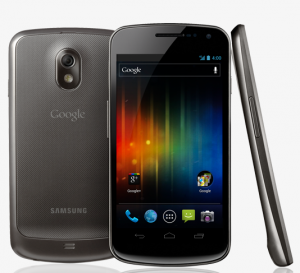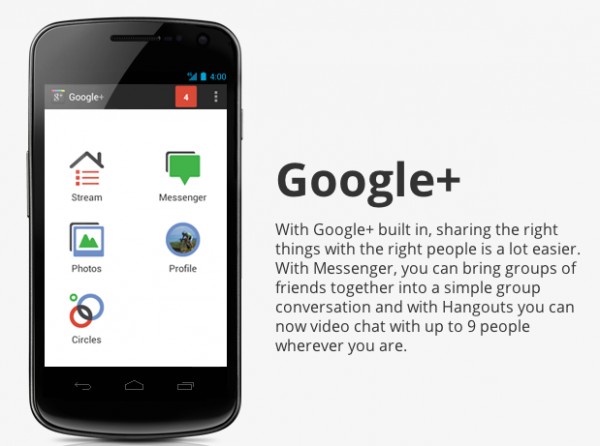Having Won The Land War, Google Is Now After “Hearts And Minds” With Ice Cream Sandwich
With a wide array of new features and upgrades, Android 4.0 (“Ice Cream Sandwich”) launched last night in Hong Kong. The new version of the operating system unites Android for tablets and smartphones, though there are not yet any Ice Cream tablets. Honeycomb, which proved to be tablet-only, was largely a failure. (Android boss Andy Rubin says […]
 With a wide array of new features and upgrades, Android 4.0 (“Ice Cream Sandwich”) launched last night in Hong Kong. The new version of the operating system unites Android for tablets and smartphones, though there are not yet any Ice Cream tablets. Honeycomb, which proved to be tablet-only, was largely a failure. (Android boss Andy Rubin says there are 6 million Android tablets in the market.)
With a wide array of new features and upgrades, Android 4.0 (“Ice Cream Sandwich”) launched last night in Hong Kong. The new version of the operating system unites Android for tablets and smartphones, though there are not yet any Ice Cream tablets. Honeycomb, which proved to be tablet-only, was largely a failure. (Android boss Andy Rubin says there are 6 million Android tablets in the market.)
The debut Ice Cream handset is the Samsung-built Galaxy Nexus (pictured) though other Android handsets will get the update at some point. The new Nexus will be available in November, though the developer SDK is available now. It’s the first “beautiful” and “intuitive” Android device, according to the launch superlatives.
(Microsoft CEO Steve Ballmer joked last night that you had to be a “computer scientist” to use Android.)
Google Wants You To Love Android
We haven’t had a chance to hold and use the phone yet. But others have said this is the first Android device that feels “completely cohesive and coherent” (read: like an iPhone). Indeed, Google has moved beyond powering what is quickly becoming the world’s dominant mobile computing platform; it now really wants you to love your device.
Google wants to inspire the same kind of devotion to Android that Apple owners have for their hardware. It also wants to match Apple service for service, including music and media, so there’s no perceived gap or deficiency in Android’s feature set. Andy Rubin confirmed yesterday at the “D” conference in Asia that Google would soon launch a music service “with a twist.”
The fundamental problem with Google’s desire to create desire for Android devices is that there are simply too many of them. That Windows PC-like distribution has been the engine behind Android’s success to date. But the dizzying array of phones and the fact that there’s a new “flagship” practically every time we turn around creates a “too many choices” problem. Though “choice” is what the Android fans celebrate over the “top-down” or “lock down” approach of Apple.
Galaxy Nexus vs. Razr vs. The Next “Flagship”
Yesterday, for example, also saw the unveiling of Motorola’s new flagship Android device, the reinvented Razr. Supposedly the thinnest Android handset to date, the Razr is coming to Verizon in the U.S. and will cost $299 with a contract. As an aside, this pricing violates the $199 smartphone ceiling of competing devices, including the iPhone. As a result, the Razr is likely to sell poorly, especially if the new Nexus comes in at $199.
Yet the fact that two splashy Android smartphones launched on the same day is a metaphor for the problem Google faces in gaining iPhone-like emotional attachment to Android. There is no “GPhone,” merely an ever-evolving succession of more Android devices.
Quality can be another issue with Android. Google doesn’t really have control over the hardware quality of its numerous Android handsets and has limited control over hardware and software integration (maybe that will change with the Motorola acquisition). Samsung is the leading global Android handset vendor. But its devices often feel “plasticky” and cheap. (The Galaxy Tab 10.1 tablet running Honeycomb is a disaster of a user experience.)
We’ll see with the Galaxy Nexus. From a distance it’s a very impressive handset with impressive specs, though ordinary consumers generally don’t care about specs; they care about particular features and the overall “look and feel” of the device.
Big Screen, Speed, Face Unlock
One of the things that will likely stand out to consumers is the Galaxy Nexus’ massive high-resolution screen: 4.65 inches. The additional fact that it will run on the fastest networks will also tip some people in the direction of this device vs. the iPhone, which hasn’t integrated 4G capability yet.
Speed and screen size are the two big differentiators vs. the iPhone from an “ordinary consumer” perspective. However it’s interesting to see what Google is promoting and what it thinks are the phone’s marquee features. Here’s what Google is pitching to the public:
- Android 4.0 (“advanced”)
- Face Unlock (this is both about simplicity and intended to “wow”)
- Android Beam (an NFC-based alternative to “Bump”)
- Voice Typing (not new but Google is promoting speech in the wake of Siri, with some improvements apparently)
- Google+ (Google believes this will resonate as a feature and is using Android in the battle against Facebook)
- Camera (no shutter lag)
- Display and design (this is the first “sensuous” Android phone)
- 4G speed
In one way of looking at it, Face Unlock is Ice Cream Sandwich’s version of Siri — a “wow” feature that will get plenty of notice and public discussion. However in this case it’s more of a marketing tool for Google/Android rather than a consumer utility like Siri (though perhaps it emerges as a practical deterrent to thieves). The NFC-powered Android Beam is also impressive but not an immediate “selling feature” of the phone. Geeks will immediately embrace it but regular folks won’t understand it until they use it.
Behind Android Beam is NFC, making the Galaxy Nexus the second Android device after the Nexus S that can take advantage of Google Wallet. Just this week Google Wallet rolled out more features and more merchants.
Will Android Mainstream Google+?
Google recently announced 40 million Google+ users. But it’s not clear how many of those are regular, active users. There are some indications that growth at Google+ has cooled a bit.
Interestingly Google+ is being promoted as one of the top features on the Galaxy Nexus and in Ice Cream Sandwich: group messaging, group video chat and private sharing. Android may be Google’s most effective tool to mainstream Google+ beyond the “power users” and early adopters who’ve taken to it.
Now a Two-Horse Race
The press loves to focus on the Android vs. iPhone competition. And I’m guilty of that too. But what’s more significant is how Android and the iPhone together are grabbing so much mindshare they’re crowding out everyone else.
WebOS is (tragically) effectively gone from the market. RIM is still selling a lot of handsets, especially outside the U.S., but the company is in real trouble and falling further behind in terms of consumer appeal. One might say that RIM is the “Yahoo of smartphones,” a company with a large audience and powerful brand that is rapidly fading.
Windows Phones are very capable and do many things as well or better than their rivals. Browser speed is an example. But overall Microsoft hasn’t yet given consumers a compelling reason to buy them in large numbers. It’s not a me-too phone, but consumers largely see it that way. The hope is that the forthcoming Nokia hardware and Microsoft software combination will be very competitive. I spoke yesterday to a Nokia employee who said that the forthcoming devices were very nice indeed. But their success is by no means assured.
Nokia has a large installed base of users who will presumably upgrade to Nokisoft devices when they appear later this year. But a bad launch or an initial handset that fails to “wow” could result in more market share losses for the one-time smartphone leader, as well as sow doubt about Windows Phones’ future.
Too Much Success?
There’s no question that Galaxy Nexus will be successful. The Galaxy line of smartphones for Samsung has sold well globally and the company has spent millions around the world promoting them.
According a recent estimate from Canalys, Android powered devices represented nearly 50 percent of all smartphones shipped in Q2. By Q1 next year Android will likely be the top smartphone platform globally, though the iPhone remains the top individual device.
Android’s massive success is partly behind Google’s recently announced mobile ad revenue growth. Along those lines I was told yesterday that Google’s Click to Call program is now generating “millions of calls each week.” Very quickly Google is eclipsing other mobile advertising rivals. It also controls more than 95 percent of mobile search, a much higher share percentage than on the desktop.
Too much more success and market share and regulators will become more aggressively involved. Android is already on the list of things the U.S. government is looking into as part of the larger antitrust inquiry. Google needs healthy and vibrant competitors in the mobile arena. There need to be at least three to keep everyone honest. Apple is certainly going to be one of those; the question is whether the other will be Microsoft or RIM.
[youtube]https://www.youtube.com/watch?v=ISh2Cp4AFnM[/youtube]
Contributing authors are invited to create content for Search Engine Land and are chosen for their expertise and contribution to the search community. Our contributors work under the oversight of the editorial staff and contributions are checked for quality and relevance to our readers. The opinions they express are their own.
Related stories
New on Search Engine Land
